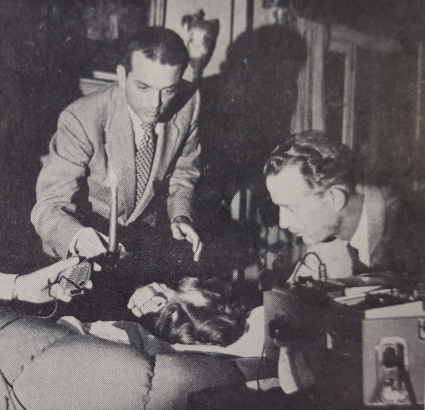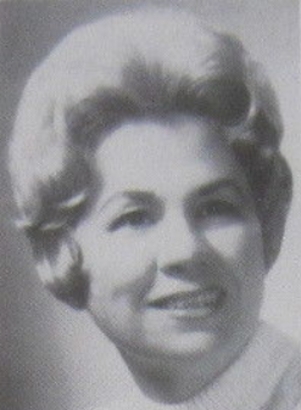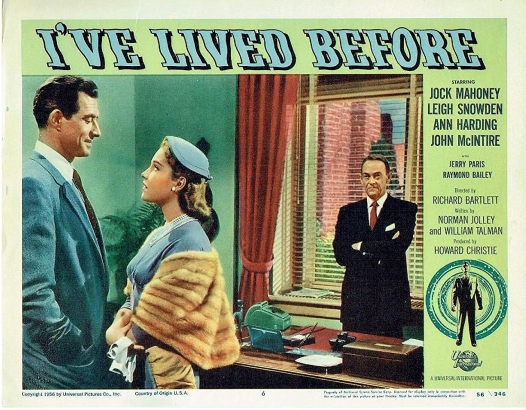In 1952, a young businessman named Morey Bernstein – third generation proprietor of the Bernstein Brothers Equipment Company of Pueblo, Colorado – witnessed an act of hypnotism at a dinner party, and became almost immediately enamored with the subject. He began seeking out every book on the subject he could lay his hands on, forgoing for a time all novels and other forms of entertainment in favor of learning everything there was to know on the subject of hypnotism. After awhile, he felt he was ready to give it a go himself, and with his first two subjects he ostensibly alleviated his wife Hazel’s persistent migraine headache and allegedly cured the stutter of a borderline suicidal college student (the nephew of a family friend).
In fact, if Bernstein is to be believed (which is certainly a question deserving some attention), he successfully treated a variety of ailments, including smoking cessation and insomnia, using the amazing power of hypnosis and post-hypnotic suggestions. However, those tales are all a prelude to the subject from which his fame arose. The story was initially serialized by William J. Barker in the Denver Post’s Empire Magazine supplement in 1954 and catapulted the notion of past life regression into the public consciousness.
The subject of Bernstein’s attention (and source of his notoriety) was Pueblo native Virginia Tighe, though she was referred to as “Ruth Mills Simmons” to protect her privacy (at her request). Under hypnosis, Tighe told of her past life as a woman named Bridey Murphy, born on December 20, 1798, in the town of Cork, Ireland. The tale was slowly drawn out over a series of sessions and revealed remarkable details (many startlingly accurate). Among the specifics she mentioned were her husband’s name and profession, the name of the church in which they were wed and even how she had died falling down a flight of stairs. She even recounted attending her own funeral! Another remarkable detail was that as she told this life story under hypnosis, she spoke with a thick Irish brogue, a characteristic completely lacking in her ‘waking’ tone. All things considered, it’s not hard to see why the story seemed so believable on its face, nor why it would capture the imagination of the country.
Unfortunately, Bernstein, anxious to share his amazing discovery with the world, wrote his book The Search for Bridey Murphy without doing much in the way of due diligence. While the astonishing “true story” captivated the cultural attention, there were many who were skeptical and unwilling to take the tale at face value. Once people actually started investigating Tighe’s claims, much of the tale began to unravel.
Among many examples of inconsistencies and inaccuracies, the church in which Bridey and her husband (Sean Joseph Brian McCarthy) were married, St. Theresa’s Church in Belfast, wasn’t built until 1911 (47 years after her “death” in 1864). Her husband was identified as a barrister, but a Catholic would have been barred from holding that title until the Catholic Emancipation in 1829, a very significant detail which she suspiciously never mentioned. Even simple things like purchasing clothing in shops, rather than purchasing cloth and having a dress made by a dressmaker (which would have been the norm at that time), bring up significant questions as to the validity of the tale.
Further investigations revealed even more damning details. While Tighe (born Virginia Mae Reese) was primarily raised by her Norwegian uncle and his wife, both her parents were part Irish and she lived with them until she was three. Even more significantly, an Irish immigrant named Bridey Murphy Corkell lived across the street from Virginia’s childhood home.
It’s important to note that it doesn’t appear there was any deliberate deception on anyone’s part throughout this tale. Investigators concluded that most of Tighe’s “past life” memories could be attributed to cryptomnesia. Cryptomnesia occurs when the brain recalls a memory, but doesn’t recognize it as such and is, in a sense, the antithesis of “false memories,” which is when something which never actually happened is recognized by the brain as being a memory. Since many of the corollary events in Tighe’s life happened when she was an infant/toddler, it’s likely that the memories were fragmented and incomplete. Pair this with Bernstein’s amateur status and, in many cases, very leading questions, and Tighe’s brain likely picked out these scraps of information and constructed a narrative around them. Virginia Tighe didn’t like the spotlight (evidenced by the fact that she insisted on Bernstein’s use of a pseudonym) and was reportedly skeptical about the very notion of reincarnation, even when it came to her own experience.
Regardless, it became a national phenomenon. There was a film based on Bernstein’s book, as well as other films and numerous songs inspired or informed by the tale. “Come As You Were” parties became a sensation wherein attendees were expected to dress as they believed they would have been in a previous life. The tale was famously satirized by comedian Stan Freberg. There was even a cocktail (dubbed the “Reincarnation Cocktail”) inspired by the craze. And, of course, the term “past life regression” is still a routinely used phrase.
For more on this fascinating tale, we have multiple clippings files on the subject. You can also find the entire saga, as it played out, in the Denver Post microfilm collection. We also have a copy of Bernstein’s book, The Search for Bridey Murphy, and even the vinyl record which contains audio of the first experiment!
As always, this and more can be found in the Western History and Genealogy department, and liking our Facebook page will ensure you don’t miss out on any updates.





Comments
Awesome story Chris! Thanks!
Awesome story Chris! Thanks!
Thanks Christine! Glad you
Thanks Christine! Glad you enjoyed it!
Fascinating story. Makes me
Fascinating story. Makes me wonder wonder if the concept of “past life regression” is used as a real thing in the mental health field today.
I'm 84 years old and have
I'm 84 years old and have lived through the period. Believe me, most that have followed the story at the time and might have believed in the story as fact no longer believe in "past life regression." At the time I was a skeptic -- It's in my nature -- I don't believe in Aliens from other worlds, mental telepathy, etc. I also believe it is a waste of time and money to go to Mars. But what do I know?
Not by reputable
Not by reputable psychiatrists or psychologists, but it's certainly a concept which still exists in less rigorously regulated fields. Thanks for your interest!
Thank you for resurrecting
Thank you for resurrecting this colorful story from Colorado history in the 1950s. The name of the Denver Post columnist who wrote about it was actually William J. Barker. His son was a high school friend of mine at the time.
You are indeed correct that
You are indeed correct that it was Barker, not Butler. Thank you for bringing this mistake to my attention... we'll get the text corrected as soon as possible!
With respect to "reputable
With respect to "reputable psychiatrists", etc., please research Dr. Brian Weiss and his experience which contradicted education and life's work as a scientist.
Funny how memory works. I
Funny how memory works. I would have sworn that I heard about Bridey in 1953. I have always associated it with a house my family lived in from the summer of 1952-to the summer of '53 (10 years old). Like everyone else, I wanted it to be true. It was a decade later when I discovered Bridey's facts were fallacious.
I am skeptic about the…
I am skeptic about the skeptisim raised here.
Yes, it could be that all is true all together
Both the past life and the in accuracy details and her familiarity with the Irish woman.
One of the things we know about past life, is that we attract the people we are gamiliar with. So her being with Irish again is not surprising.
Add new comment